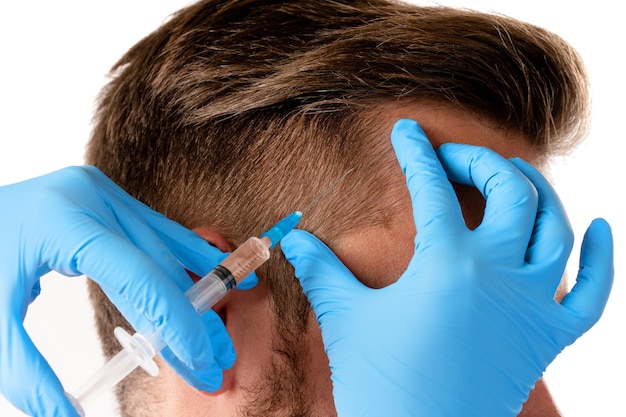Platelet-Rich Plasma (PRP) therapy has emerged as a popular and effective method for addressing hair loss and enhancing hair volume. Utilizing the body’s own regenerative capabilities, PRP therapy stimulates hair follicles and promotes new hair growth. However, achieving the best results from PRP In Dubai requires proper preparation. Understanding how to prepare for your PRP hair treatment can significantly impact the effectiveness of the procedure and ensure a smooth experience.
Understanding PRP Therapy
Before diving into preparation tips, it’s important to understand the PRP therapy process. PRP therapy involves drawing a small amount of your blood, processing it to concentrate the platelets, and then injecting this concentrated plasma into targeted areas of the scalp. The platelets contain growth factors that help rejuvenate hair follicles and stimulate new hair growth.
Step 1: Initial Consultation
The first step in preparing for PRP therapy is scheduling an initial consultation with a qualified practitioner. During this consultation, the following aspects will be addressed:
- Assessment of Hair Loss: The practitioner will evaluate your hair loss pattern, scalp condition, and overall health. This assessment helps determine if PRP therapy is suitable for you and establishes a personalized treatment plan.
- Medical History Review: It’s crucial to provide a detailed medical history, including any current medications, allergies, or medical conditions that may affect the treatment. This information helps the practitioner identify any potential risks or contraindications.
- Treatment Goals: Discuss your expectations and goals for the treatment. Understanding what you hope to achieve will help the practitioner tailor the PRP therapy to meet your specific needs.
Step 2: Pre-Treatment Guidelines
Following your consultation, your practitioner will provide specific pre-treatment guidelines to ensure you are well-prepared for the PRP procedure. Key aspects to consider include:
- Avoid Blood Thinners: For at least one week before the treatment, avoid medications and supplements that can affect blood clotting, such as aspirin, ibuprofen, and fish oil. Blood thinners can impact the quality of the PRP and potentially affect the results.
- Hydration: Drink plenty of water in the days leading up to your appointment. Proper hydration helps ensure the blood sample is of high quality, which can enhance the effectiveness of the PRP therapy.
- Avoid Alcohol and Caffeine: Refrain from consuming alcohol and excessive caffeine in the days prior to your treatment. Both substances can dehydrate the body and potentially affect the blood’s composition.
- No Hair Products: On the day of your appointment, avoid using hair products such as gels, sprays, or oils. Clean hair and scalp are essential for the treatment, as products can interfere with the PRP injections and overall procedure.
Step 3: Day of the Procedure
On the day of your PRP hair treatment, follow these additional steps to ensure a smooth process:
- Arrive Early: Arrive at the clinic a little early to complete any necessary paperwork and allow yourself to relax before the procedure.
- Comfortable Clothing: Wear comfortable clothing to your appointment. Since the procedure involves drawing blood and injections, wearing something loose-fitting can help you feel more at ease.
- Communicate Concerns: If you have any concerns or questions about the procedure, make sure to communicate them with your practitioner before the treatment begins. Addressing any uncertainties can help you feel more confident and relaxed.
Step 4: The PRP Procedure
During the PRP procedure, the following steps will be carried out:
- Blood Draw: A small amount of blood will be drawn from your arm, similar to a routine blood test. This blood is then processed to concentrate the platelets.
- Preparation of PRP: The blood sample is placed in a centrifuge, which separates the platelets from other blood components. The resulting Platelet-Rich Plasma is then prepared for injection.
- Scalp Preparation: Your scalp will be cleaned thoroughly to remove any residues or oils. A local anesthetic or numbing cream may be applied to minimize discomfort during the injections.
- Injection: The PRP is injected into specific areas of the scalp where hair thinning or loss is evident. The injections are typically made in a grid-like pattern to ensure even coverage.
Step 5: Post-Treatment Care
Following the PRP procedure, proper aftercare is essential to optimize results and ensure a smooth recovery:
- Avoid Washing Hair: Do not wash your hair for at least 24 to 48 hours after the treatment. This allows the PRP to settle into the scalp and be absorbed by the hair follicles.
- Avoid Heat and Chemicals: Steer clear of exposing your scalp to excessive heat, such as from saunas or hot showers, and avoid using harsh hair products or dyes for a few days.
- Maintain Hydration: Continue to drink plenty of water and maintain a healthy diet to support overall health and aid in the recovery process.
- Follow-Up Appointments: Adhere to any follow-up appointments scheduled by your practitioner to monitor progress and assess the effectiveness of the treatment.
Potential Side Effects and What to Expect
While PRP therapy is generally well-tolerated, some individuals may experience mild side effects, such as:
- Redness or Swelling: Temporary redness or swelling at the injection sites is common and usually subsides within a few days.
- Tenderness: The scalp may be tender for a short period after the treatment. This discomfort typically resolves on its own.
It’s important to follow your practitioner’s instructions carefully and report any unusual or persistent symptoms during your recovery.
Conclusion!
Proper preparation is key to maximizing the benefits of PRP therapy for hair restoration. By following the pre-treatment guidelines, understanding what to expect on the day of the procedure, and adhering to post-treatment care instructions, you can enhance the effectiveness of the therapy and achieve the best possible results.
PRP therapy offers a natural and effective solution for those looking to improve hair volume and combat thinning hair. By working closely with a qualified practitioner and taking the necessary steps to prepare for your treatment, you can embark on a successful journey toward revitalized, fuller hair.






Comments